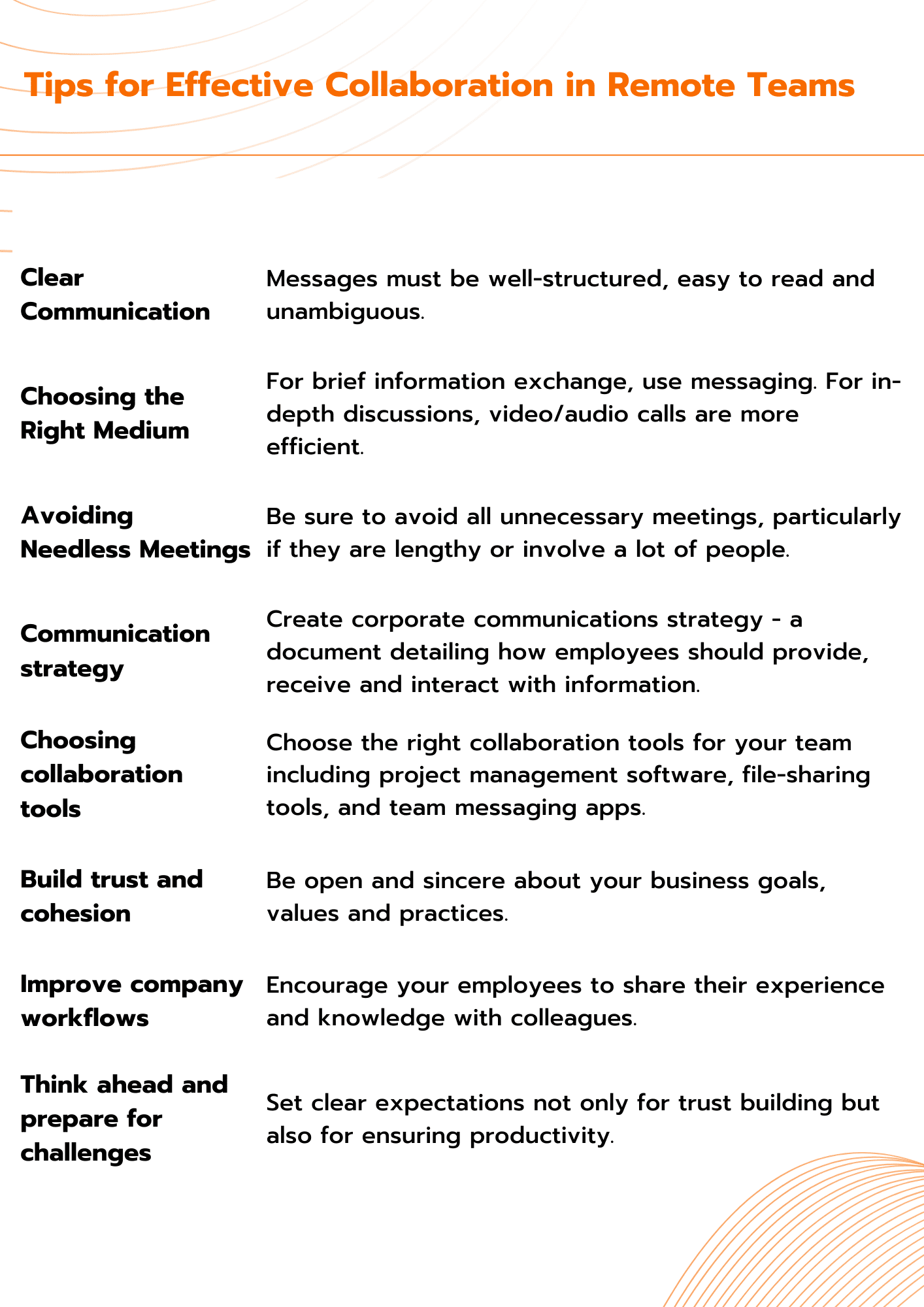
- Apr 17, 2024
- 9 min read
10 Techniques on How to Foster Effective Collaboration in Remote Teams
Staff Augmentation

Vitalii Samofal
CTO
The world is moving towards online work. In 2022, 26% of US experts worked online. In 2018, this was 6%. Similar numbers are in other places. In the EU, 30% of the workers have remote or mixed work options.
Online workers have a better work-life balance and lower stress. Companies can hire experts worldwide. First, this increases the talent pool. Second, it cuts down office costs. Online hiring is also faster. And it offers more opportunities.
Remote teams are groups of experts working online. They share information via digital means. In this article, we will discuss how to improve virtual communication.
Challenges of Online Work
Online work and team management have several dangers.
Challenges of Online Communication
The main dangers of online communication are:
– Misunderstandings
When messaging, people don't see faces or body language. They don't hear the intonation and volume. These details can give context. They can even change the meaning. For example, people can misunderstand jokes and sarcasm.
The situation is worse when people from high and low-context cultures talk. The former means that people use words to express meaning. For the latter, visual and vocal signals are key.
– Lack of access
This is common for companies where most people work offline. These workers discuss issues face-to-face and use office resources. So, remote staff might feel left behind. It can be difficult for them to get information.
Building Trust in Remote Teams
Difficulties can lead to a lack of trust. Workers might question each other's goals and skills. Keep reading for our tips on building trust in online teams.
Managing Remote Team Dynamics
Remote team dynamics define staff behavior and communication style. This notion can feel fuzzy. But when mismanaged, the consequences are real.

Tips for Effective Collaboration in Remote Teams
Effective Collaboration in Remote Teams: Techniques and Strategies
Softkit has gathered 13 techniques, strategies and best practices for remote team collaboration. We grouped them into 4 categories.
Communication in Virtual Teams
Discussing priorities and context is important for online teams. We offer these effective communication strategies for remote teams:
#1. Encourage clear communication
Messages must be clear and easy to read. Group messages should have enough information for everyone to understand the context. Offer staff advice on improving their collaboration skills. You can organize a webinar on remote team collaboration and communication strategies.
#2. Choose the best tools for each task
There are many tools for online communication. Teams can use
– messaging,
– video and audio calls,
– emails,
– joined online documents, etc.
Choosing the best tool for each situation is important for productivity.
If you need the opinions of several people, include each in the discussion. But do not bother staff with issues that do not concern them.
For brief information exchange, use messaging. For detailed discussions, video and audio calls are better. Joined online documents are also useful. There you can collect data from different people.
#3. Avoid long meetings
Avoid all unnecessary meetings. Long meetings with many people are the worst. Each person needs time to prepare and take part in a meeting. Let's imagine we have a 1-hour meeting for 10 people. The meeting will take around 10 hours of working time. This is the same as one person losing a whole day.
#4. Create a communication strategy
A communications strategy is an important document. It describes how workers should give and receive information. The document should include:
– Introduction. Describe the company and its goals.
– The description of existing and proposed communication methods.
– Recommendations about business communications.
– Advice on how to talk to clients and investors.
– The description of who must tell which information to what people.
– KPIs of successful communication.
– Conclusion.
Below are communication strategy examples. Notable organizations created them:
– Communication and Engagement Strategy for Conwy County Borough.
– Communications Strategy for the University of Cambridge.
– Communication Strategy 2021-2026 for HIAL.
Pro tip: Not everyone might read the document. It is better to discuss it during a webinar.
Distance collaboration tools
Internet and collaboration software are important for online cooperation.
#5. Research collaboration software
The demand for cooperation software has been growing over the past years. In 2016, it reached 8.9 billion USD. In 2022 it was 13.7 billion USD. It will likely reach 18 billion by 2027. Improving virtual team collaboration solutions is beneficial.
Popular software for collaboration in a remote work environment is:
– Microsoft products (23.7% market share),
– Zoom (19%),
– Google apps (11.3%),
– Cisco tools (7.4%) and
– Slack (5.1%).
Many companies use custom software and software integrations. They are great for improving remote work collaboration. Thus, CRMs can work with analytics tools. Billing apps can coordinate with management apps and more. The information updates everywhere in real-time. There is no need to spend time copying information. This means more time and better results.
#6. Use these essential tools for remote team collaboration:
1) Messengers
Messengers send and receive information in real-time. They can solve many difficulties. Also, messaging apps keep a record of communication. It is easy to search. If you forget something, there is no need to ask again.
Popular messengers for business communication include
– Slack,
– Microsoft Teams,
– Google Hangouts.
To communicate with clients, companies use:
– LinkedIn,
– Facebook Messenger,
– WhatsApp and
– Telegram.
2) Video & audio meetings
Online meetings are great for improving remote team collaboration. Workers can discuss ideas, problems and approaches. But, avoid unnecessary, long meetings.
Popular software solutions for online meetings are:
– Zoom,
– Google Meet,
– Microsoft Teams,
– Google Hangouts,
– Skype and
– Cisco Webex.
3) Online collaboration tools
Online documents offer the best practices for remote team management and collaboration. Workers can use online spreadsheets, presentations, and word documents. Examples of online office suits are:
– Google Workspace,
– Microsoft 365,
– Zoho Office Suite and
– iWork.
Also, online whiteboards can help staff visualize their ideas. It is very efficient when used with audio meetings. Popular digital whiteboards are:
– Microsoft Whiteboard,
– Google Jamboard,
– Mural and
– Crayon.
Many companies also use a web app for creating designs called Figma.
4) File sharing
File sharing is a part of effective remote collaboration strategies. Popular services are:
– Microsoft OneDrive,
– Google Drive,
– Apple iCloud Drive,
– Dropbox and
– Box.
Strategies for effective remote team collaboration include business libraries and archives. They offer valuable instructions and educational materials. Make them easy to search and read. You can use diagrams, schemes, tables and other visuals. Businesses also add audio and text-to-speech software. This makes information more accessible.
5) Project & task management tools
Managing remote team members demands good software. Look for a solution that includes the following:
– Task management features, like Gantt charts, Scrum and Kanban boards;
– Budgeting tools;
– Resource handling features;
– Progress tracking tools. Examples are burndown charts and statistics.
Popular project management software is:
– Asana,
– Monday,
– Trello and
– Confluence.
6) Online calendars
Group calendars are great for enhancing collaboration in remote teams. Managers can be sure that everyone knows about company events and meetings. Some group calendars can sync with workers' private calendars. Many calendars also let teammates see each other's schedules. This makes organizing a meeting easier.
Popular calendar apps are:
– Google Calendar,
– Outlook Calendar,
– Apple Calendar,
– ClickUp and
– Calendly.
H4 #7. Compare the benefits of each tool to your needs
Cooperation software is excellent. Efficient tools improve productivity by 30%. It also helps to save time and resources.
But many options are available. Choosing the best can be difficult. To make a choice:
- List your needs.
- Consider your operating system.
- Think about third-party integrations.
- Decide how many people need the software.
- Study pricing.
- Compare your options.
Remote Team Building
In successful remote teams, workers feel like friends. Here are 3 ways how to encourage such relationships:
#8. Build trust
The key to building trust in remote teams is honesty. Be open about your business goals. Is your company trying to save the world? Does it want to earn money? Be truthful about your priorities. Set clear expectations for your staff and be open to questions and suggestions.
Also, prevent bad behavior. Do not permit workplace cyberbullying.
#9. Offer remote team-building activities
Team building is key to improving collaboration and teamwork in remote teams. Here are great remote team-building activities:
– Creating a space for casual talk
Create a chat or an online break room. Here people will share memes, jokes and thoughts on various topics.
– Online educational events
Many companies organize workshops and online learning sessions. It brings teammates together, encourages knowledge-sharing and improves staff expertise.
– Sharing company news
Share important company news in group chats. This will drive engagement and improve morale.
– Playing online games together
If there are gamers on your team, they can play together. This can increase trust and improve cooperation.
– Live remote coworking
People can use video or audio calls while editing online documents together.
– Celebrating holidays
Strategies for remote team-building include holiday celebrations. You can organize an offline event or a contest. Or you can send workers gifts. Online contests are also great. For example, offer staff to take a photo of their Christmas trees. The prettiest tree wins a prize.
#10 Improve remote team motivation
Building a successful remote team through collaboration needs regular encouragement. Here are some ways how to achieve it:
– Surveys
You can track the morale of your team with regular surveys. This will help you find problems.
– Feedback
Good or bad – feedback is important. It helps people understand whether their results are good. Feedback also tells workers what they need to change.
– Explaining the bigger picture
Make sure your workers understand company goals. This will allow them to make better suggestions.
– Health & learning benefits
Benefits are great for motivation. They show your staff that you care about their well-being and skill improvement. Health benefits are healthcare insurance, gym membership and wellness programs. Learning benefits are language classes, professional courses, certifications and conferences.
– Encouraging new ideas
Workers feel inspired when they help the company's success.
Productivity Tips
Productivity in remote teams is one of the top concerns for many managers. Learn how to improve collaboration in virtual teams. Here are our top productivity tips:
#11. Think ahead and prepare for challenges
You can improve remote work productivity by:
– Set clear priorities and expectations
Clear expectations are critical for trust building and productivity. Priorities help avoid confusion.
– Create a documentation strategy
Document your processes. Keep documentation organized. This will save time and make your team more efficient.
– Prepare for technical issues
Problems appear at some point. Back up your data and make sure that your projects do not have a single point of failure.
#12. Use best practices for online work
Improve team efficiency with these remote collaboration best practices:
– Create a high-value archive
We mentioned it when discussing file-sharing tools. You can create a business library or an archive for your team. Remember that it must be easy to search. If you add videos, include subtitles.
– Give workers a voice
Encourage your staff to share their experience and knowledge with colleagues. They can host workshops or add articles to the business library.
– Increase the value of online meetings
Several things can make your meetings more efficient. First, provide workers with the meeting agenda and relevant documents beforehand. This will help them prepare.
In the end, make a summary. If your discussion had many points, email staff after the event. The email should include the list of reached decisions. You can also record meetings.
#13. Describe remote working benefits to attract talent
Online work makes your company more attractive. Most experts want to work fully remotely. Talk about the benefits of online work in your job descriptions. These are:
– No need to drive to work
Less time driving means more free time. This leads to a better work-life balance. This also saves money.
– Greater freedom
Workers can choose whether to work from home, a cafe or another space. Online workers can move to another city or country. And moving away from large cities decreases living costs.
– Comfort
Online workers have greater control over their working space. Hence, they can make it more comfortable.
– More opportunities
Experts are not limited as much by their location. They can look for career opportunities in other cities. If they find one, there is no need to move.
– Less harm to the environmental
Less driving is better for the environment. This, in turn, leads to better health and quality of life. Check out our articles on choosing coders and a CTO.
Softkit – A Trusted Tech Partner
At Softkit, we know how to organize online work. Our coders live in 14 cities in 5 European countries. Our clients come from 9 countries worldwide.
This helped us stand up to challenges. We complete 99.8% of our projects on time. Moreover, each client is ready to recommend us to their business partners. Softkit has great reviews on international websites like Clutch. Tell us about your project.
Conclusion
Online work is changing the world. You can fight it and fall behind. Or you can accept it to get ahead. Yet, organizing online work demands knowledge. Thus, managers need to:
– choose good software,
– encourage clear communication,
– organize team-building activities
– track and improve team mood.
FAQ
1. What is a remote and virtual team?
A remote team (aka a distributed or a virtual team) is a group of specialists working online and sharing information via digital means.
Some argue that there are differences between remote, distributed and virtual teams, but there is no universal agreement on what those differences are.
2. What is the most effective way to collaborate remotely?
Effective remote collaboration requires proper tools, clear communication and trust-building. Read the “Effective collaboration in remote teams: techniques and strategies” section for more information.
3. What is the importance of communication & collaboration in a software project?
Clear communication and regular collaboration are critical for the success of a software project. Without them, the developers can end up creating a product that doesn’t solve business challenges.
4. How can a team collaborate remotely?
Teams can collaborate remotely using dedicated software. Read the Distance Collaboration Tools section for insights on different types of collaboration software (not sponsored).
Subscribe to our blog
Fill out the form below to receive a free consultation and find out how Softkit can help your business grow.